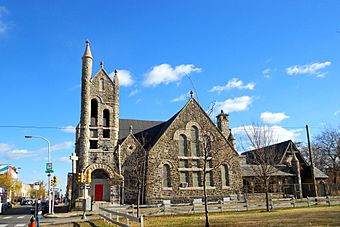McDowell Memorial Presbyterian Church facts for kids
Quick facts for kids |
|
|
McDowell Memorial Presbyterian Church
|
|
 |
|
| Location | 2040 Cecil B. Moore Avenue Philadelphia, Pennsylvania |
|---|---|
| Built | 1891–1893 |
| Architect | Henry Augustus Sims and J. William Shaw |
| Architectural style | Richardson Romanesque |
| NRHP reference No. | 13000744 |
| Added to NRHP | September 18, 2013 |
The McDowell Memorial Presbyterian Church is a beautiful and historic church located in north Philadelphia, Pennsylvania. This special building was designed by talented architects Henry Augustus Sims and J. William Shaw. It stands out because of its unique style, known as Richardson Romanesque.
In September 2013, the church was officially added to the National Register of Historic Places. This means it's recognized as an important part of American history and culture.
Contents
Discovering the Church's Unique Style
The McDowell Memorial Presbyterian Church was built between 1891 and 1893. Its design is a great example of the Richardson Romanesque style. This style was popular in the late 1800s. It was named after a famous architect, Henry Hobson Richardson.
What is Richardson Romanesque?
Buildings in the Richardson Romanesque style often look strong and grand. They use rough, heavy stone and have round arches over windows and doors. You might also see tall towers and deep-set windows. These features give the church a very solid and impressive look.
Who Designed This Historic Building?
The church was designed by two architects, Henry Augustus Sims and J. William Shaw. They worked together to create this lasting structure. Their design shows off the classic features of the Richardson Romanesque style, making the church a true architectural treasure in Philadelphia.
Why is This Church a Historic Place?
The McDowell Memorial Presbyterian Church is important for several reasons. It's a great example of its architectural style. It also tells a story about the history of Philadelphia and the community it served.
Joining the National Register of Historic Places
Being listed on the National Register of Historic Places means a building is special. It helps protect these places for future generations to enjoy and learn from. The McDowell Memorial Presbyterian Church earned this honor in 2013. This recognition highlights its value as a historical landmark.
Images for kids







